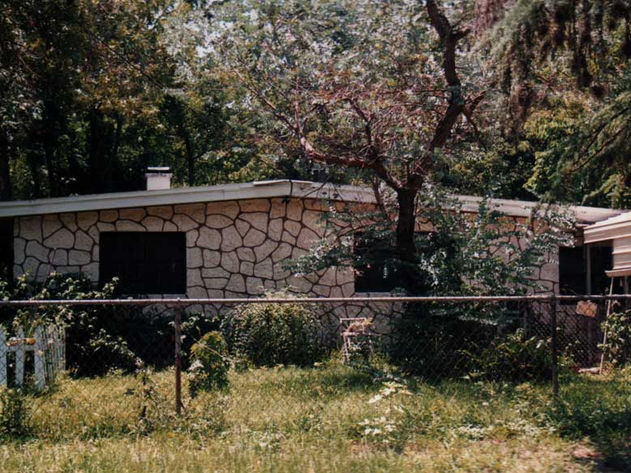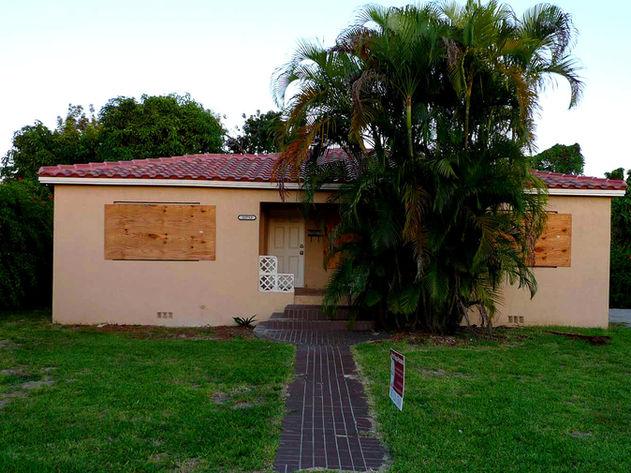Failed Optimism:
The Original American Suburbs
The streets are silent; the sidewalks are covered with grass like archeological finds. Cars are parked like armor in front of houses. Anyone you might encounter outside is guarded with a fierce stare and uneasy fear.
The architecture is the contrary: with friendly decorative concrete designs, patterns, bright colors, awnings, and a backdrop of a surreally blue Florida sky. These are the streets of early suburban neighborhoods across Florida from Jacksonville to Miami. They are a stark contrast between today's new bland and faux architecture. These homes stand apart like exotic flowers in an urban jungle.
We imagine the first inhabitants of these places:
Dick and Jane see Spot run. Dishwasher day-dreamers.

A generation with complete faith in the system that has led us to the road we are all so desperately trying to diverge from as it crumbles beneath our feet. To untangle the international web that this system wove and is still weaving would require the same propaganda techniques employed to deceive us initially.
Post-war Men, like the Bowerbird, constructed homes designed to keep their wives and raise their children while they were away working in the inner city. What they were working on would eventually make this "nuclear family" fractured. With industrialization came mass production, and soon mother and wife were separated from the home, as she had graduated from society and was now deemed capable of work outside the home.
Appliances, canned food, frozen dinners, baby formula, anything in exchange for time. Children raised by others as Mother brought home a second income. Not only did this increase the cost of living as families now had combined revenues, but it also separated women from the natural bonding that a child needs in the early years of life, priming them for a life of consumption to achieve illusionary emotional fulfillment and happiness.
Consumption became a lifestyle. Appliances were sold as futuristic and revolutionary, and products were consumed as identity markers. Product mythologies entered every home through advertising: TV, radio, print, and even the waste from the product itself as it enters its last stage of life as trash. Consumer ideology saturates the global media and is devouring our civilization like the plague. In a consumer society, enough is never enough. There is a longing for more and better: a need that is never satiated.
Micro[Pollen]tin: Like bees in a corporate hive. Better than Suburbia, a corporate town and its own metropolitan:
The idea of suburban neighborhoods spawned a phenomenon of ideal living propaganda. The idea is a ploy for corporations to house and feed their workers. In the old mining towns of the past, miners would work for room, board, and coupons that were only exchangeable for goods at company stores, which usually charged higher prices than regular retailers. It is slightly less evident in more modern living situations, as seen in "Micropolitans," such as Plano, Texas. This little place was nearly a ghost town before ten major American corporations decided to buy it all up and put their corporate headquarters in its center. Outside its center, they have contracted developers to build popular franchised restaurants, a plethora of themed shopping, a cinema, and two different lifestyle living situations. One is the popular suburban dream of a house, a yard, and a garage; the other is a more city-style apartment living just outside the shopping and eating place. Little do most employees of the corporations know that after they get their salary from Frito-Lay and spend it at the Plano cinema or Plano grocery store, they are just returning the money to Frito-Lay or Bank of America. (These names are used, for example, but they are a part of this micropolitan of Plano, Texas.) It is like a herding technique that involves deep-rooted psychology of the fragile emotions of the human mind and the disgusting greed of money and ego.
It is ironic that the ideas behind Suburbia, the concepts of protecting, nurturing, and connecting with a community, have been negated. Instead, Suburbia has become the very utility that has separated community and facilitated an isolated, competitive consumer lifestyle. Suburbia is now mass-produced across the globe to house workers and impose a franchised lifestyle of work, consumption, and sleep.
These photographs seek to capture the reminiscence of these homes and ideas. Perhaps these neighborhoods will be replaced with duplexes, tower blocks, and paved parking lots. They are a part of our cultural archaeology, provide great insight into our current civilization, and could offer us a perspective from which to look into our future.
















